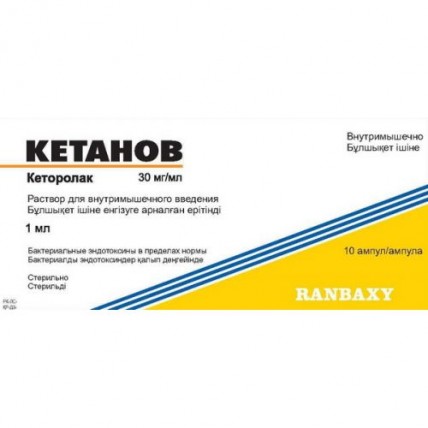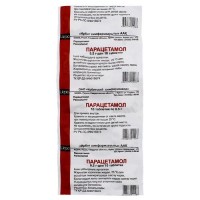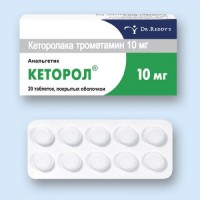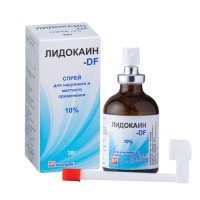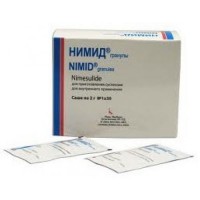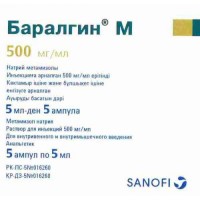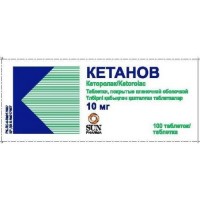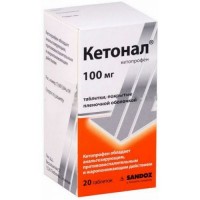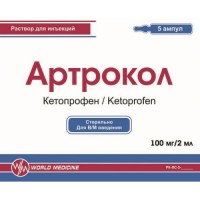Ketanov 30 mg / ml solution 10s the / m
- $10.20
The instruction for medical use
of medicine
Ketanov
the Trade name
Ketanov
the International unlicensed
name Ketorolak Lekarstvennaya a form
Solution for intramuscular introduction of 30 mg/ml Structure
of 1 ml contains
active agent - a ketorolak of a trometamol of 30 mg
excipients: sodium chloride, dinatrium edetat, sodium hydroxide, ethanol, water for injections
the Description
Transparent colourless or pale yellow color liquid.
Pharmacotherapeutic group
Non-steroidal anti-inflammatory drugs. Derivatives of acetic acid.
The code of automatic telephone exchange M01AB15
the Pharmacological
Ketorolak's Pharmacokinetics properties trometamol represents racemic mix
of S- and
R-enantiomerov at the same time anesthetizing action is caused
S by a form.
After intramuscular introduction, ketorolak it is quickly and completely soaked up. The maximum concentration in blood plasma after intramuscular introduction of a single dose of 30 mg is reached in 50 minutes and makes 2.2 mkg/ml.
The linear pharmacokinetics
At adults, after intramuscular introduction of a ketorolak of a trometamol in the recommended range of doses, clearance of a racemate does not change. The pharmacokinetics of a ketorolak of a trometamol after introduction single and repeated doses has linear character. At higher recommended doses, there is a proportional increase in concentration of a free and connected racemate. Does not cross a blood-brain barrier. Ketorolak gets through a placenta and a small amount of drug gets to breast milk. More than 99% of a ketorolak in blood plasma contact proteins.
Ketorolak trometamol is metabolized in a liver, with formation pharmacological of inactive metabolites.
The main way of removal of a ketorolak and its metabolites are kidneys. About 92% of the entered dose are removed by kidneys, about 40% in the form of metabolites and 60% in the form of not changed ketorolak. About 6% of a dose are removed through intestines.
Elimination half-life of S-enantiomera of a ketorolak of a trometamol approximately made 2.5 hours (SD & plusmn, 0.4) in comparison with 5 hours (SD & plusmn, 1.7) for R-enantiomera. In other researches, elimination half-life for a racemate is celebrated within 5-6 hours.
The renal failure
On the basis of only a single dosage, average elimination half-life of a ketorolak of a trometamol at patients with the weakened function of kidneys makes 6-19 hours and depends on a damage rate. Between clearance of creatinine and the general clearance of a ketorolak of a trometamol the elderly patients and patients with a renal failure (r=0.5) have a weak interrelation.
A liver failure
At patients with an abnormal liver function clinically significant changes of pharmacokinetics of drug are noted.
The pharmacodynamics
Ketanov non-steroidal anti-inflammatory drug (NPVS), has analgetic effect. The mechanism of action of Ketanov, as well as other NPVP, is connected with inhibition of synthesis of prostaglandins. The biological activity of a ketorolak of a trometamol is caused by a S-form. Analgeziruyushchy action comes approximately in 30 min., the maximum analgesic effect develops in 2-3 h, the maximum analgesia proceeds from 1 to 2 hours. Duration of analgeziruyushchy action is 46 h and more depending on a dose. Ketones does not render sedative or anxiolytic effect, does not influence opioid receptors. Ketones do not possess the oppressing action on a respiratory center and does not strengthen the respiratory depression and sedation caused by opioid analgetics.
Indications
- a pain syndrome of average and strong intensity (including in the postoperative period)
Ketanov appoint the Route of administration and doses in a minimal effective dose which is defined depending on intensity of pain and response of the patient. Purpose of repeated daily dosages of Ketanov intramusculary should not exceed 2 days since. side reactions can increase at long use. Undesirable influence can be reduced when using the least effective dose during the shortest period necessary for control of symptoms.
Adults and teenagers are more senior than 16 years with the body weight exceeding 50 kg
the Initial dose for stopping of pain makes 10 mg intramusculary with the subsequent introductions in a dose of 10-30 mg each 4-6 hours if necessary. Ketanov it is possible to enter into the initial postoperative stage intramusculary every 2 hour if necessary. The maximum daily dose for patients should not exceed 90 mg. At elderly people, patients with a renal failure and patients with body weight to 50 kg the maximum daily dose should not exceed 60 mg, a course - up to 2 days. For patients weighing less than 50 kg, it is necessary to lower a dosage.
Upon transition from parenteral administration of Ketanov, the dose of both dosage forms should not exceed 90 mg (60 mg - for elderly patients, patients with a renal failure and also patients with body weight less than 50 kg) and at the same time the drug dose in tablets in day of transition should not exceed 40 mg. Patients have to be transferred to an oral way of introduction to the shortest period.
Opioid analgetics (e.g., morphine, pethidine) can be used in parallel, for achievement of optimum analgeziruyushchy effect during the early postoperative period when pain the strongest. At co-administration of Ketanov and opioid drug of a dose of the last can be reduced.
However it is necessary to consider side effects of opioid means, especially at one-day surgeries.
Elderly patients
For patients are more senior than 65 years, it is not recommended to exceed the general daily dose of 60 mg.
A renal failure
Ketorolak is contraindicated in an average or heavy renal failure, at easy degree of a renal failure it is necessary to lower a dose (no more than 60 mg/days in oil)
Side effects
- dryness in a mouth, a stomacace, nausea, vomiting, a stomach ache, feeling of overflow of a stomach, gastritis, an esophagitis, an eructation, a meteorism, a constipation, diarrhea
- pancreatitis, exacerbation of colitis and Crohn's disease, GIT erosive cankers, including perforation or gastrointestinal bleedings (a melena, vomiting as a coffee thick)
- a disorder of vision, including. illegibility of visual perception, optic neuritis
- dizziness, a headache
- drowsiness, insomnia, unusual dreams, perspiration, nervousness, paresthesia, functional disturbances, pathological thinking, a depression, spasms, a polydipsia, inability to concentrate, concern, fatigue, excitement, a spatial disorientation, disturbances of taste, myalgia, confusion, hallucinations, a hyperkinesia, a hearing loss, sonitus, aseptic meningitis (especially at patients with the available autoimmune disorders, such as system lupus erythematosus, diseases of connective tissue)
- urination increase, an oliguria, a hyponatremia, a hyperpotassemia, a back pain (with or without hamaturia), increase in concentration of urea and creatinine in blood serum, interstitial nephrite, an ischuria, a nephrotic syndrome, an acute renal failure, an azotemia, a gemolitiko-uraemic syndrome (hemolytic anemia, a renal failure, thrombocytopenia, a purpura), swell renal genesis
- abnormal liver functions, hepatitis, a hepatomegalia, cholestatic jaundice, a liver failure
- inflows, bradycardia, pallor, arterial hypertension, a stethalgia, swell, heart failure, a myocardial infarction or a stroke, a fluid lungs
- a purpura, thrombocytopenia, a neutropenia, an eosinophilia, an agranulocytosis, aplastic anemia, hemolytic anemia
- skin rash, an itching, a small tortoiseshell, photosensitivity of skin, Stephens-Johnson's syndrome, a toxic epidermal necrolysis (Lyell's disease), exfoliative dermatitis, makulopapullezny rashes
- allergic reactions: an anaphylaxis or anaphylactoid reactions (weight in a thorax, goose breathing, breath difficulty, bronchial asthma, a bronchospasm, a tachypnea, an asthma, a laryngeal edema or dispnoe, a purpura, a Quincke's edema, exfoliative and violent dermatitis, swell a century, periorbital swelled)
- postoperative bleedings from wounds, hematomas, epistaxis, increase in a blood clotting time
- an asthenia, swell (persons, shins, anklebones, fingers, a foot), it is rare - a paraglossa, increase in weight, fever
-
Contraindication infertility
- hypersensitivity to a ketorolak or other NPVS, and auxiliary ingredients of drug
- GIT erosive cankers in an active phase or gastrointestinal bleedings, formation of ulcers or perforation in the anamnesis
- heavy heart failure
- a state after performing aortocoronary shunting
- a renal failure of average and heavy severity (creatinine of blood serum & gt, 160 µmol/l)
- suspicion or the confirmed cerebrovascular bleeding
- hemorrhagic diathesis, including fibrillation disturbance
- a full or incomplete combination a polypose of a nose, a Quincke's disease and a bronchospasm
- a Quincke's disease, a bronchospasm, bronchial asthma, including in the anamnesis
- to the patients continuing to receive acetylsalicylic acid
- simultaneous use with other NPVS, pentoksifilliny, probenetsidy or lithium salt
- a hypovolemia, dehydration
- bleedings or high risk of their development
- pregnancy and the period of a lactation
- children's age up to 16 years
- for anesthesia before and during surgeries because of high risk of bleeding
Medicinal interactions
Warfarin, digoxin, salicylate and
In vitro heparin ketorolak reduces linking of warfarin with proteins of plasma a little (from 99.5% to 99.3%) at concentration in plasma of 5-10 mkg/ml. Linking of digoxin with blood proteins ketorolak does not change. At therapeutic concentration (300 mkg/ml) of in vitro salicylates the binding of a ketorolak decreased from 99.2% to 97.5% that potentially can lead to increase in plasma concentration of an untied ketorolak twice, respectively, the patients receiving high doses of salicylates ketorolak need to appoint with care.
Therapeutic concentration of digoxin, an ibuprofen, Naproxenum, acetaminophen, Phenytoinum, tolbutamide, piroxicam did not influence proteinaceous binding of a ketorolak.
Aspirin: at joint introduction of Ketanov with aspirin, its proteinaceous binding decreases though the clearance of a free ketorolak does not change. As well as when using other NPVP, the accompanying Ketanov's introduction and aspirin usually is not recommended because of a possibility of increase in side effects.
Diuretics: simultaneous use with diuretics can lead to decrease in diuretic effect and increase in risk of nephrotoxicity of NPVS.
Probenetsid: led combined use of Ketanov with probenetsidy to decrease in clearance of a ketorolak and increase in level of a ketorolak in blood plasma and also its elimination half-life. Therefore contraindicated accompanying Ketanov's use with probenetsidy.
Lithium: NPVS lead to increase in level of lithium in plasma and to reduction of renal clearance of lithium. Average minimum concentration of lithium increased by 15%, and the renal clearance decreased approximately by 20%. Thus, at the accompanying introduction of NPVS and lithium, it is necessary to examine carefully patients on presence of signs of toxicity of lithium.
Anticoagulants: it is necessary to be careful at Ketanov's introduction with anticoagulants since the accompanying introduction can cause the enhanced anti-coagulative effect.
Cardiac glycosides: NPVS can provoke developing of heart failure, reduce glomerular filtration rate and increase the level of concentration of cardiac glycoside in blood plasma at simultaneous use with the last.
Methotrexate: it is necessary to be careful at simultaneous use with a methotrexate as it was noted that some drugs which oppress biosynthesis of prostaglandins reduce clearance of a methotrexate, and, as a result, increase its toxicity.
AKF inhibitors: there is an increased risk of developing of a renal failure at simultaneous use of Ketanov with inhibitors angiotensin - the converting enzyme, especially at patients with deficit of weight.
Antiepileptic drugs: sporadic cases of convulsions at the accompanying use of a ketorolak of a trometamol and antiepileptic drugs (dipheninum, carbamazepine) are noted.
Psychotropic drugs: hallucinations when using a ketorolak at the patients accepting psychotropic drugs are noted (fluoxetine, tiotiksen, to alprazola).
Pentoksifillin: at sopustvuyushchy introduction Ketanov and a pentoksifillina, sushchestut the raised bleeding trend.
Not depolarizing muscle relaxants: in postmarketing experience cases of possible interaction between ketorolaky trometamoly and not depolarizing muscle relaxants which caused an apnoea are noted. The accompanying use of a ketorolak of a trometamol with muscle relaxants officially was not studied.
Cyclosporine: as well as when using all NPVP, it is necessary to be careful at the accompanying administration of cyclosporine because of the increased risk of nephrotoxicity.
Mifepristone: NPVS should not be applied within 8-12 days after intake of mifepristone as the efficiency of mifepristone
Corticosteroids can decrease: as well as when using all NPVP, it is necessary to be careful at the accompanying introduction with corticosteroids because of the increased risk of gastrointestinal bleeding.
Hinolona: the patients accepting hinolona and NPVS can have the increased risk of developing convulsions.
b-blockers: ketorolak and other non-steroidal anti-inflammatory drugs can reduce antihypertensive effect of b-blockers and can increase risk of a renal failure at the accompanying introduction with AKF inhibitors, especially at patients with deficit of weight.
Special instructions
Undesirable effects can be minimized, using the smallest effective dose during the shortest period of the use necessary for control of symptoms of a disease.
Use at elderly patients: at elderly the increased frequency of development of side reactions after reception of NPVS is observed. In comparison with young adult patients, at elderly the plasma elimination half-life is extended and the plasma clearance of a ketorolak decreases. At use Ketanov intramusculary is not recommended to exceed the general daily dose of 60 mg. At use in the form of tablets the long interval between doses is recommended.
Influence on fertility: use Ketanov, as well as any drug of cyclooxygenase/prostaglandin inhibiting synthesis, can worsen fertility and is not recommended to the women planning conception.
Impact on digestive tract: Ketones it is contraindicated to patients with earlier established ulcer of stomach and duodenum and/or gastrointestinal bleeding. Ketorolaka trometamol can cause serious gastrointestinal by-effects, including bleeding, an ulceration and perforation of a stomach, small or large intestine that can lead to death. These serious by-effects can appear at any time, with or without the warning symptoms, at patients who were treated Ketorolak trometamoly.
In addition to the anamnesis of a peptic ulcer, other factors increasing risk of gastrointestinal bleeding at patients who were treated by NPVS include the accompanying use of oral corticosteroids, or anticoagulants, longer NPVS therapy, smoking, alcohol intake, advanced age and the general weak state of health. For patients with a high risk it is necessary to take the alternative treatment which is not including NPVS into account.
Hematologic influence: as prostaglandins play an important role in a hemostasis, and NPVS inhibit aggregation of thrombocytes and prolong a bleeding time, patients with disturbance of coagulation need to take with caution Ketanov and to make careful observation. The patients accepting anticoagulants for any reason have an increased risk of formation of an intramuscular hematoma because of introduction Ketanov.
Anemia is sometimes observed at patients of the accepting NPVS, including ketorolak. It can happen because of a delay of liquid, the concealed or volume gastrointestinal hemorrhage, or incompleteness of the described impact on an erythrogenesis. To the patients who are on long-term treatment with use of NPVS, including Ketanov, it is necessary to check hemoglobin or a hematocrit if they show any symptoms or symptoms of anemia.
Ketanov at the patients who underwent operations with high risk of bleeding or an incomplete hemostasis is not recommended to use.
From a respiratory system: patients with asthma can have aspirinovy asthma. Use of aspirin at patients with aspirinovy asthma is connected with a heavy bronchospasm which can have a lethal outcome. As the cross-responsiveness, including a bronchospasm, between aspirin and other means of nonsteroid anti-inflammatory therapy at such patients susceptible to aspirin is noted, patients cannot appoint Ketanov with this form of susceptibility to aspirin and it is necessary to use with care at patients with the preexisting asthma.
Use at patients with an abnormal liver function: patients from the liver weakened by function or the postponed diseases of a liver need to take with caution Ketanov. Increase in one or several indicators of hepatic tests can be observed. These deviations are temporary, can remain not changed or to progress in case of use continuation. In case of development of clinical signs or symptoms which meet in liver diseases or in case of system manifestations Ketanov's use should be stopped.
Use at patients with a renal failure: considering that Ketanov and his metabolites are removed mainly by kidneys, patients with moderate or heavy disturbance of renal function (creatinine of blood serum is higher than 160 µmol/l) cannot accept Ketanov. Patients with a small renal failure need to accept the reduced dose of a ketorolak (no more than 60 mg/days in oil) and their condition of kidneys needs to be observed carefully.
When using Ketorolak's, cases of an acute renal failure, interstitial nephrite and a nephrotic syndrome are noted.
Use at patients with cardiovascular diseases: The corresponding observation and consultation are necessary for patients with the postponed hypertensia and/or slight or moderate coronary heart disease as the delay of liquid and hypostasis are noted in connection with NPVS therapy. NPVS, including Ketanov, can lead to appearance of new hypertensia or deterioration in the preexisting hypertensia, any of them can promote the increased emergence of the cardiovascular phenomena. In NPVS initiation of treatment means and during a course of treatment it is necessary to check arterial blood pressure carefully.
Patients with uncontrollable hypertensia, the coronary heart disease established by coronary heart disease, a peripheral arterial disease and/or a cerebrovascular disease need to be treated only the Ketanovy ambassador of careful inspection. Similar examination needs to be performed before long treatment of patients with risk factors for a cardiovascular disease (e.g., hypertensia, a lipidemia, diabetes, smoking).
Delay of liquid and hypostasis: the delay of liquid and hypostasis are noted when using a ketorolak and therefore it needs to be used with care at patients with heart failure, hypertensia.
Anaphylactoid reactions: Patients cannot enter ketones with an aspirinovy triad. This syndrome usually appears at the patients with asthma having rhinitis with or without nasal polyps or at the patients showing heavy, a bronchospasm with a possible lethal outcome after intake of aspirin or other NPVP. Anaphylactoid reactions, such as anaphylaxis, can have a lethal outcome. In case of anaphylactoid reactions it is necessary to ask for emergency aid.
Skin reactions: NPVS, including ketorolak, can cause serious skin side reactions, such as exfoliative dermatitis, Stephens-Johnson's syndrome and toxic epidermal necrosis which can have a lethal outcome. These serious phenomena can appear without prevention. It is necessary to warn patients about signs and symptoms of serious skin manifestations and it is necessary to stop use of drug at the first appearance of skin rash or any other symptoms of an allergy.
Features of influence of medicine on ability to run the vehicle or potentially dangerous mechanisms
At some patients drowsiness, dizziness, a spatial disorientation, insomnia, fatigue, a disorder of vision or a depression after Ketanov's use can be observed. If at patients these or other similar undesirable phenomena are observed, it is necessary to refrain from control of motor transport and work with mechanisms.
Overdose
Symptoms: block, drowsiness, nausea, vomiting, pains in epigastric area which are usually reversible by means of the supporting treatment. There can be gastrointestinal bleeding. In rare instances there can be hypertensia, an acute renal failure, respiratory depression and a coma. Anaphylactoid reactions at therapeutic intake of NPVS are noted, they can appear after overdose.
Treatment: symptomatic and maintenance therapy. It is necessary to accept activated carbon within one hour after reception of potentially harmful amount of drug. To carry out monitoring of function of kidneys and a liver. Specific antidote does not exist. The artificial diuresis, hemodialysis or hemoperfusion can not help because of high proteinaceous binding.
The form of release and packing
On 1 ml of drug place in ampoules of transparent glass of I type with a blue strip. On 10 ampoules together with the instruction for medical use in the state and Russian languages place in a cardboard pack.
To Store storage conditions in the place protected from light at a temperature not higher than 25 wasps.
To store out of children's reach!
2 years
not to use a period of storage after expiry date.
Prescription status
According to the prescription
S.C.TERAPIA S.A. Producer, Romania
Str. Fabricii, nr 124, Cluj-Napoca 400632
the Name and the country of the owner of the registration certificate
of Ranbaxy Laboratories Limited, India
the Address of the organization accepting in the territory of the Republic of Kazakhstan claims from consumers on quality of products
Almaty, Manas St. 32A, BC SAT, office 602
ph.: 8-800-080-5202
el. address: Almaty.kz@ranbaxy.
To develop
of medicine
Ketanov
the Trade name
Ketanov
the International unlicensed
name Ketorolak Lekarstvennaya a form
Solution for intramuscular introduction of 30 mg/ml Structure
of 1 ml contains
active agent - a ketorolak of a trometamol of 30 mg
excipients: sodium chloride, dinatrium edetat, sodium hydroxide, ethanol, water for injections
the Description
Transparent colourless or pale yellow color liquid.
Pharmacotherapeutic group
Non-steroidal anti-inflammatory drugs. Derivatives of acetic acid.
The code of automatic telephone exchange M01AB15
the Pharmacological
Ketorolak's Pharmacokinetics properties trometamol represents racemic mix
of S- and
R-enantiomerov at the same time anesthetizing action is caused
S by a form.
After intramuscular introduction, ketorolak it is quickly and completely soaked up. The maximum concentration in blood plasma after intramuscular introduction of a single dose of 30 mg is reached in 50 minutes and makes 2.2 mkg/ml.
The linear pharmacokinetics
At adults, after intramuscular introduction of a ketorolak of a trometamol in the recommended range of doses, clearance of a racemate does not change. The pharmacokinetics of a ketorolak of a trometamol after introduction single and repeated doses has linear character. At higher recommended doses, there is a proportional increase in concentration of a free and connected racemate. Does not cross a blood-brain barrier. Ketorolak gets through a placenta and a small amount of drug gets to breast milk. More than 99% of a ketorolak in blood plasma contact proteins.
Ketorolak trometamol is metabolized in a liver, with formation pharmacological of inactive metabolites.
The main way of removal of a ketorolak and its metabolites are kidneys. About 92% of the entered dose are removed by kidneys, about 40% in the form of metabolites and 60% in the form of not changed ketorolak. About 6% of a dose are removed through intestines.
Elimination half-life of S-enantiomera of a ketorolak of a trometamol approximately made 2.5 hours (SD & plusmn, 0.4) in comparison with 5 hours (SD & plusmn, 1.7) for R-enantiomera. In other researches, elimination half-life for a racemate is celebrated within 5-6 hours.
The renal failure
On the basis of only a single dosage, average elimination half-life of a ketorolak of a trometamol at patients with the weakened function of kidneys makes 6-19 hours and depends on a damage rate. Between clearance of creatinine and the general clearance of a ketorolak of a trometamol the elderly patients and patients with a renal failure (r=0.5) have a weak interrelation.
A liver failure
At patients with an abnormal liver function clinically significant changes of pharmacokinetics of drug are noted.
The pharmacodynamics
Ketanov non-steroidal anti-inflammatory drug (NPVS), has analgetic effect. The mechanism of action of Ketanov, as well as other NPVP, is connected with inhibition of synthesis of prostaglandins. The biological activity of a ketorolak of a trometamol is caused by a S-form. Analgeziruyushchy action comes approximately in 30 min., the maximum analgesic effect develops in 2-3 h, the maximum analgesia proceeds from 1 to 2 hours. Duration of analgeziruyushchy action is 46 h and more depending on a dose. Ketones does not render sedative or anxiolytic effect, does not influence opioid receptors. Ketones do not possess the oppressing action on a respiratory center and does not strengthen the respiratory depression and sedation caused by opioid analgetics.
Indications
- a pain syndrome of average and strong intensity (including in the postoperative period)
Ketanov appoint the Route of administration and doses in a minimal effective dose which is defined depending on intensity of pain and response of the patient. Purpose of repeated daily dosages of Ketanov intramusculary should not exceed 2 days since. side reactions can increase at long use. Undesirable influence can be reduced when using the least effective dose during the shortest period necessary for control of symptoms.
Adults and teenagers are more senior than 16 years with the body weight exceeding 50 kg
the Initial dose for stopping of pain makes 10 mg intramusculary with the subsequent introductions in a dose of 10-30 mg each 4-6 hours if necessary. Ketanov it is possible to enter into the initial postoperative stage intramusculary every 2 hour if necessary. The maximum daily dose for patients should not exceed 90 mg. At elderly people, patients with a renal failure and patients with body weight to 50 kg the maximum daily dose should not exceed 60 mg, a course - up to 2 days. For patients weighing less than 50 kg, it is necessary to lower a dosage.
Upon transition from parenteral administration of Ketanov, the dose of both dosage forms should not exceed 90 mg (60 mg - for elderly patients, patients with a renal failure and also patients with body weight less than 50 kg) and at the same time the drug dose in tablets in day of transition should not exceed 40 mg. Patients have to be transferred to an oral way of introduction to the shortest period.
Opioid analgetics (e.g., morphine, pethidine) can be used in parallel, for achievement of optimum analgeziruyushchy effect during the early postoperative period when pain the strongest. At co-administration of Ketanov and opioid drug of a dose of the last can be reduced.
However it is necessary to consider side effects of opioid means, especially at one-day surgeries.
Elderly patients
For patients are more senior than 65 years, it is not recommended to exceed the general daily dose of 60 mg.
A renal failure
Ketorolak is contraindicated in an average or heavy renal failure, at easy degree of a renal failure it is necessary to lower a dose (no more than 60 mg/days in oil)
Side effects
- dryness in a mouth, a stomacace, nausea, vomiting, a stomach ache, feeling of overflow of a stomach, gastritis, an esophagitis, an eructation, a meteorism, a constipation, diarrhea
- pancreatitis, exacerbation of colitis and Crohn's disease, GIT erosive cankers, including perforation or gastrointestinal bleedings (a melena, vomiting as a coffee thick)
- a disorder of vision, including. illegibility of visual perception, optic neuritis
- dizziness, a headache
- drowsiness, insomnia, unusual dreams, perspiration, nervousness, paresthesia, functional disturbances, pathological thinking, a depression, spasms, a polydipsia, inability to concentrate, concern, fatigue, excitement, a spatial disorientation, disturbances of taste, myalgia, confusion, hallucinations, a hyperkinesia, a hearing loss, sonitus, aseptic meningitis (especially at patients with the available autoimmune disorders, such as system lupus erythematosus, diseases of connective tissue)
- urination increase, an oliguria, a hyponatremia, a hyperpotassemia, a back pain (with or without hamaturia), increase in concentration of urea and creatinine in blood serum, interstitial nephrite, an ischuria, a nephrotic syndrome, an acute renal failure, an azotemia, a gemolitiko-uraemic syndrome (hemolytic anemia, a renal failure, thrombocytopenia, a purpura), swell renal genesis
- abnormal liver functions, hepatitis, a hepatomegalia, cholestatic jaundice, a liver failure
- inflows, bradycardia, pallor, arterial hypertension, a stethalgia, swell, heart failure, a myocardial infarction or a stroke, a fluid lungs
- a purpura, thrombocytopenia, a neutropenia, an eosinophilia, an agranulocytosis, aplastic anemia, hemolytic anemia
- skin rash, an itching, a small tortoiseshell, photosensitivity of skin, Stephens-Johnson's syndrome, a toxic epidermal necrolysis (Lyell's disease), exfoliative dermatitis, makulopapullezny rashes
- allergic reactions: an anaphylaxis or anaphylactoid reactions (weight in a thorax, goose breathing, breath difficulty, bronchial asthma, a bronchospasm, a tachypnea, an asthma, a laryngeal edema or dispnoe, a purpura, a Quincke's edema, exfoliative and violent dermatitis, swell a century, periorbital swelled)
- postoperative bleedings from wounds, hematomas, epistaxis, increase in a blood clotting time
- an asthenia, swell (persons, shins, anklebones, fingers, a foot), it is rare - a paraglossa, increase in weight, fever
-
Contraindication infertility
- hypersensitivity to a ketorolak or other NPVS, and auxiliary ingredients of drug
- GIT erosive cankers in an active phase or gastrointestinal bleedings, formation of ulcers or perforation in the anamnesis
- heavy heart failure
- a state after performing aortocoronary shunting
- a renal failure of average and heavy severity (creatinine of blood serum & gt, 160 µmol/l)
- suspicion or the confirmed cerebrovascular bleeding
- hemorrhagic diathesis, including fibrillation disturbance
- a full or incomplete combination a polypose of a nose, a Quincke's disease and a bronchospasm
- a Quincke's disease, a bronchospasm, bronchial asthma, including in the anamnesis
- to the patients continuing to receive acetylsalicylic acid
- simultaneous use with other NPVS, pentoksifilliny, probenetsidy or lithium salt
- a hypovolemia, dehydration
- bleedings or high risk of their development
- pregnancy and the period of a lactation
- children's age up to 16 years
- for anesthesia before and during surgeries because of high risk of bleeding
Medicinal interactions
Warfarin, digoxin, salicylate and
In vitro heparin ketorolak reduces linking of warfarin with proteins of plasma a little (from 99.5% to 99.3%) at concentration in plasma of 5-10 mkg/ml. Linking of digoxin with blood proteins ketorolak does not change. At therapeutic concentration (300 mkg/ml) of in vitro salicylates the binding of a ketorolak decreased from 99.2% to 97.5% that potentially can lead to increase in plasma concentration of an untied ketorolak twice, respectively, the patients receiving high doses of salicylates ketorolak need to appoint with care.
Therapeutic concentration of digoxin, an ibuprofen, Naproxenum, acetaminophen, Phenytoinum, tolbutamide, piroxicam did not influence proteinaceous binding of a ketorolak.
Aspirin: at joint introduction of Ketanov with aspirin, its proteinaceous binding decreases though the clearance of a free ketorolak does not change. As well as when using other NPVP, the accompanying Ketanov's introduction and aspirin usually is not recommended because of a possibility of increase in side effects.
Diuretics: simultaneous use with diuretics can lead to decrease in diuretic effect and increase in risk of nephrotoxicity of NPVS.
Probenetsid: led combined use of Ketanov with probenetsidy to decrease in clearance of a ketorolak and increase in level of a ketorolak in blood plasma and also its elimination half-life. Therefore contraindicated accompanying Ketanov's use with probenetsidy.
Lithium: NPVS lead to increase in level of lithium in plasma and to reduction of renal clearance of lithium. Average minimum concentration of lithium increased by 15%, and the renal clearance decreased approximately by 20%. Thus, at the accompanying introduction of NPVS and lithium, it is necessary to examine carefully patients on presence of signs of toxicity of lithium.
Anticoagulants: it is necessary to be careful at Ketanov's introduction with anticoagulants since the accompanying introduction can cause the enhanced anti-coagulative effect.
Cardiac glycosides: NPVS can provoke developing of heart failure, reduce glomerular filtration rate and increase the level of concentration of cardiac glycoside in blood plasma at simultaneous use with the last.
Methotrexate: it is necessary to be careful at simultaneous use with a methotrexate as it was noted that some drugs which oppress biosynthesis of prostaglandins reduce clearance of a methotrexate, and, as a result, increase its toxicity.
AKF inhibitors: there is an increased risk of developing of a renal failure at simultaneous use of Ketanov with inhibitors angiotensin - the converting enzyme, especially at patients with deficit of weight.
Antiepileptic drugs: sporadic cases of convulsions at the accompanying use of a ketorolak of a trometamol and antiepileptic drugs (dipheninum, carbamazepine) are noted.
Psychotropic drugs: hallucinations when using a ketorolak at the patients accepting psychotropic drugs are noted (fluoxetine, tiotiksen, to alprazola).
Pentoksifillin: at sopustvuyushchy introduction Ketanov and a pentoksifillina, sushchestut the raised bleeding trend.
Not depolarizing muscle relaxants: in postmarketing experience cases of possible interaction between ketorolaky trometamoly and not depolarizing muscle relaxants which caused an apnoea are noted. The accompanying use of a ketorolak of a trometamol with muscle relaxants officially was not studied.
Cyclosporine: as well as when using all NPVP, it is necessary to be careful at the accompanying administration of cyclosporine because of the increased risk of nephrotoxicity.
Mifepristone: NPVS should not be applied within 8-12 days after intake of mifepristone as the efficiency of mifepristone
Corticosteroids can decrease: as well as when using all NPVP, it is necessary to be careful at the accompanying introduction with corticosteroids because of the increased risk of gastrointestinal bleeding.
Hinolona: the patients accepting hinolona and NPVS can have the increased risk of developing convulsions.
b-blockers: ketorolak and other non-steroidal anti-inflammatory drugs can reduce antihypertensive effect of b-blockers and can increase risk of a renal failure at the accompanying introduction with AKF inhibitors, especially at patients with deficit of weight.
Special instructions
Undesirable effects can be minimized, using the smallest effective dose during the shortest period of the use necessary for control of symptoms of a disease.
Use at elderly patients: at elderly the increased frequency of development of side reactions after reception of NPVS is observed. In comparison with young adult patients, at elderly the plasma elimination half-life is extended and the plasma clearance of a ketorolak decreases. At use Ketanov intramusculary is not recommended to exceed the general daily dose of 60 mg. At use in the form of tablets the long interval between doses is recommended.
Influence on fertility: use Ketanov, as well as any drug of cyclooxygenase/prostaglandin inhibiting synthesis, can worsen fertility and is not recommended to the women planning conception.
Impact on digestive tract: Ketones it is contraindicated to patients with earlier established ulcer of stomach and duodenum and/or gastrointestinal bleeding. Ketorolaka trometamol can cause serious gastrointestinal by-effects, including bleeding, an ulceration and perforation of a stomach, small or large intestine that can lead to death. These serious by-effects can appear at any time, with or without the warning symptoms, at patients who were treated Ketorolak trometamoly.
In addition to the anamnesis of a peptic ulcer, other factors increasing risk of gastrointestinal bleeding at patients who were treated by NPVS include the accompanying use of oral corticosteroids, or anticoagulants, longer NPVS therapy, smoking, alcohol intake, advanced age and the general weak state of health. For patients with a high risk it is necessary to take the alternative treatment which is not including NPVS into account.
Hematologic influence: as prostaglandins play an important role in a hemostasis, and NPVS inhibit aggregation of thrombocytes and prolong a bleeding time, patients with disturbance of coagulation need to take with caution Ketanov and to make careful observation. The patients accepting anticoagulants for any reason have an increased risk of formation of an intramuscular hematoma because of introduction Ketanov.
Anemia is sometimes observed at patients of the accepting NPVS, including ketorolak. It can happen because of a delay of liquid, the concealed or volume gastrointestinal hemorrhage, or incompleteness of the described impact on an erythrogenesis. To the patients who are on long-term treatment with use of NPVS, including Ketanov, it is necessary to check hemoglobin or a hematocrit if they show any symptoms or symptoms of anemia.
Ketanov at the patients who underwent operations with high risk of bleeding or an incomplete hemostasis is not recommended to use.
From a respiratory system: patients with asthma can have aspirinovy asthma. Use of aspirin at patients with aspirinovy asthma is connected with a heavy bronchospasm which can have a lethal outcome. As the cross-responsiveness, including a bronchospasm, between aspirin and other means of nonsteroid anti-inflammatory therapy at such patients susceptible to aspirin is noted, patients cannot appoint Ketanov with this form of susceptibility to aspirin and it is necessary to use with care at patients with the preexisting asthma.
Use at patients with an abnormal liver function: patients from the liver weakened by function or the postponed diseases of a liver need to take with caution Ketanov. Increase in one or several indicators of hepatic tests can be observed. These deviations are temporary, can remain not changed or to progress in case of use continuation. In case of development of clinical signs or symptoms which meet in liver diseases or in case of system manifestations Ketanov's use should be stopped.
Use at patients with a renal failure: considering that Ketanov and his metabolites are removed mainly by kidneys, patients with moderate or heavy disturbance of renal function (creatinine of blood serum is higher than 160 µmol/l) cannot accept Ketanov. Patients with a small renal failure need to accept the reduced dose of a ketorolak (no more than 60 mg/days in oil) and their condition of kidneys needs to be observed carefully.
When using Ketorolak's, cases of an acute renal failure, interstitial nephrite and a nephrotic syndrome are noted.
Use at patients with cardiovascular diseases: The corresponding observation and consultation are necessary for patients with the postponed hypertensia and/or slight or moderate coronary heart disease as the delay of liquid and hypostasis are noted in connection with NPVS therapy. NPVS, including Ketanov, can lead to appearance of new hypertensia or deterioration in the preexisting hypertensia, any of them can promote the increased emergence of the cardiovascular phenomena. In NPVS initiation of treatment means and during a course of treatment it is necessary to check arterial blood pressure carefully.
Patients with uncontrollable hypertensia, the coronary heart disease established by coronary heart disease, a peripheral arterial disease and/or a cerebrovascular disease need to be treated only the Ketanovy ambassador of careful inspection. Similar examination needs to be performed before long treatment of patients with risk factors for a cardiovascular disease (e.g., hypertensia, a lipidemia, diabetes, smoking).
Delay of liquid and hypostasis: the delay of liquid and hypostasis are noted when using a ketorolak and therefore it needs to be used with care at patients with heart failure, hypertensia.
Anaphylactoid reactions: Patients cannot enter ketones with an aspirinovy triad. This syndrome usually appears at the patients with asthma having rhinitis with or without nasal polyps or at the patients showing heavy, a bronchospasm with a possible lethal outcome after intake of aspirin or other NPVP. Anaphylactoid reactions, such as anaphylaxis, can have a lethal outcome. In case of anaphylactoid reactions it is necessary to ask for emergency aid.
Skin reactions: NPVS, including ketorolak, can cause serious skin side reactions, such as exfoliative dermatitis, Stephens-Johnson's syndrome and toxic epidermal necrosis which can have a lethal outcome. These serious phenomena can appear without prevention. It is necessary to warn patients about signs and symptoms of serious skin manifestations and it is necessary to stop use of drug at the first appearance of skin rash or any other symptoms of an allergy.
Features of influence of medicine on ability to run the vehicle or potentially dangerous mechanisms
At some patients drowsiness, dizziness, a spatial disorientation, insomnia, fatigue, a disorder of vision or a depression after Ketanov's use can be observed. If at patients these or other similar undesirable phenomena are observed, it is necessary to refrain from control of motor transport and work with mechanisms.
Overdose
Symptoms: block, drowsiness, nausea, vomiting, pains in epigastric area which are usually reversible by means of the supporting treatment. There can be gastrointestinal bleeding. In rare instances there can be hypertensia, an acute renal failure, respiratory depression and a coma. Anaphylactoid reactions at therapeutic intake of NPVS are noted, they can appear after overdose.
Treatment: symptomatic and maintenance therapy. It is necessary to accept activated carbon within one hour after reception of potentially harmful amount of drug. To carry out monitoring of function of kidneys and a liver. Specific antidote does not exist. The artificial diuresis, hemodialysis or hemoperfusion can not help because of high proteinaceous binding.
The form of release and packing
On 1 ml of drug place in ampoules of transparent glass of I type with a blue strip. On 10 ampoules together with the instruction for medical use in the state and Russian languages place in a cardboard pack.
To Store storage conditions in the place protected from light at a temperature not higher than 25 wasps.
To store out of children's reach!
2 years
not to use a period of storage after expiry date.
Prescription status
According to the prescription
S.C.TERAPIA S.A. Producer, Romania
Str. Fabricii, nr 124, Cluj-Napoca 400632
the Name and the country of the owner of the registration certificate
of Ranbaxy Laboratories Limited, India
the Address of the organization accepting in the territory of the Republic of Kazakhstan claims from consumers on quality of products
Almaty, Manas St. 32A, BC SAT, office 602
ph.: 8-800-080-5202
el. address: Almaty.kz@ranbaxy.
To develop
